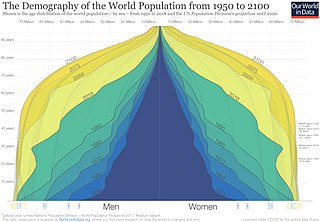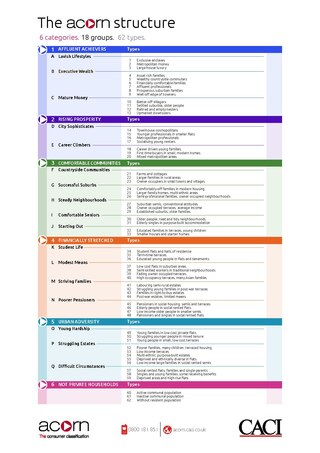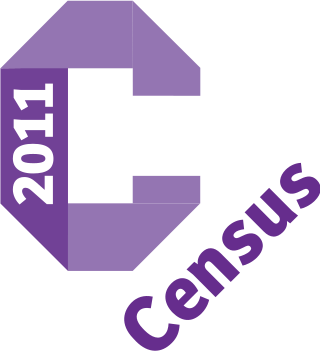Related Research Articles

Demography is the statistical study of human populations: their size, composition, and how they change through the interplay of fertility (births), mortality (deaths), and migration.
In marketing, market segmentation is the process of dividing a broad consumer or business market, normally consisting of existing and potential customers, into sub-groups of consumers based on shared characteristics.
GSS codes are nine-character geocodes maintained by the United Kingdom's Office for National Statistics (ONS) to represent a wide range of geographical areas of the UK, for use in tabulating census and other statistical data. GSS refers to the Government Statistical Service of which ONS is part.

CACI International Inc. is an American multinational professional services and information technology company headquartered in Northern Virginia. CACI provides services to many branches of the US federal government including defense, homeland security, intelligence, and healthcare.

Population geography relates to variations in the distribution, composition, migration, and growth of populations. Population geography involves demography in a geographical perspective. It focuses on the characteristics of population distributions that change in a spatial context. This often involves factors such as where population is found and how the size and composition of these population is regulated by the demographic processes of fertility, mortality, and migration.
Mosaic is Experian's system for geodemographic classification of households. It applies the principles of geodemography to consumer household and individual data collated from a number of government and commercial sources. The statistical development of the system was led by professor Richard Webber in association with Experian in the 1980s, and it has been regularly refreshed and reclassified since then, each based on more recent data from national censuses and other sources. Since its initial development in the UK, the Mosaic brand name has also been used to market separate products which classify other national consumers including most of Western Europe, USA, selected Asian regions and Australia.

Acorn, developed by CACI Limited in London, is a segmentation tool which categorises the United Kingdom’s population into demographic types. It has been built by analysing social factors and behaviour. Acorn segments households, postcodes and neighbourhoods into six categories, 18 groups and 62 types.
In marketing, geodemographic segmentation is a multivariate statistical classification technique for discovering whether the individuals of a population fall into different groups by making quantitative comparisons of multiple characteristics with the assumption that the differences within any group should be less than the differences between groups.

Aggregate data is high-level data which is acquired by combining individual-level data. For instance, the output of an industry is an aggregate of the firms’ individual outputs within that industry. Aggregate data are applied in statistics, data warehouses, and in economics.
The following outline is provided as an overview of and topical guide to marketing:
Statistical geography is the study and practice of collecting, analysing and presenting data that has a geographic or areal dimension, such as census or demographics data. It uses techniques from spatial analysis, but also encompasses geographical activities such as the defining and naming of geographical regions for statistical purposes. For example, for the purposes of statistical geography, the Australian Bureau of Statistics uses the Australian Standard Geographical Classification, a hierarchical regionalisation that divides Australia up into states and territories, then statistical divisions, statistical subdivisions, statistical local areas, and finally census collection districts.
Claritas PRIZM Premier is a set of geo-demographic segments for the United States, developed by Claritas Inc., which was owned under The Nielsen Company umbrella from 2009 to 2016.
Firmographics are sets of characteristics to segment prospect organizations.
In information science, profiling refers to the process of construction and application of user profiles generated by computerized data analysis.

A census of the population of the United Kingdom is taken every ten years. The 2011 census was held in all counties of the UK on 27 March 2011. It was the first UK census which could be completed online via the Internet. The Office for National Statistics (ONS) is responsible for the census in England and Wales, the General Register Office for Scotland (GROS) is responsible for the census in Scotland, and the Northern Ireland Statistics and Research Agency (NISRA) is responsible for the census in Northern Ireland.
A local information system (LIS) is a form of information system built with business intelligence tools, designed primarily to support geographic reporting. They overlap with some capabilities of geographic information systems (GIS), although their primary function is the reporting of statistical data rather than the analysis of geospatial data. LIS also tend to offer some common knowledge management functionality for storage and retrieval of unstructured data such as documents. They deliver functionality to load, store, analyse and present statistical data that has a strong geographic reference. In most cases the data is structured as indicators and is linked to discrete geographic areas, for example population figures for US counties or numbers claiming unemployment benefit across wards in England. The ability to present this data using data visualization tools like charts and maps is also a core feature of these systems.

Landscape-Portrait (2007) is a public digital artwork that has been touring around the UK since its launch in 2007. In 2007 public arts agency Forma commissioned the work as part of a series of public art works for the Dott Festival Newcastle, UK.
Beyond 2011, also known as The Beyond 2011 Programme, was a project initiated by the UK Statistics Authority to look at the alternatives to running a UK census in 2021. In 2008, the Treasury Select Committee had expressed concerns about the increasing cost of running the census and inaccuracies in data gathered only every ten years. In 2010 the newly elected coalition government reiterated such concerns responding to a report by the UK Statistics Authority.
Tactician Corporation is a developer and provider of GIS desktop software, SaaS web software, and business intelligence consulting services internationally. The company has its headquarters in Massachusetts, United States.
The ONS Postcode Directory (ONSPD) relates both current and terminated postcodes in the United Kingdom to a range of current statutory administrative, electoral, health and other area geographies. It also links postcodes to pre-2002 health areas, 1991 Census enumeration districts for England and Wales, 2001 Census Output Areas (OA) and Super Output Areas (SOA) for England and Wales, 2001 Census OAs and SOAs for Northern Ireland and 2001 Census OAs and Data Zones (DZ) for Scotland. It helps support the production of area based statistics from postcoded data.
References
- ↑ "BTL Consulting -- Geodemographic Research". 30 August 2005. Archived from the original on 30 August 2005.
- ↑ "rda research - geodemographic resources". 5 January 2009. Archived from the original on 5 January 2009.
- ↑ "Home - Office for National Statistics". www.statistics.gov.uk.
- ↑ Richards, S. J. (2008). "Applying Survival Models to Pensioner Mortality Data". British Actuarial Journal. 14 (2): 257–303. doi:10.1017/S1357321700001720 – via Cambridge Core.
- ↑ "CATEGORIES OF FREQUENTLY ASKED QUESTIONS (FAQ)". Archived from the original on 2008-06-07.
- ↑ "Rda research - geodemographic resources". Archived from the original on 2009-01-05. Retrieved 2008-09-19.